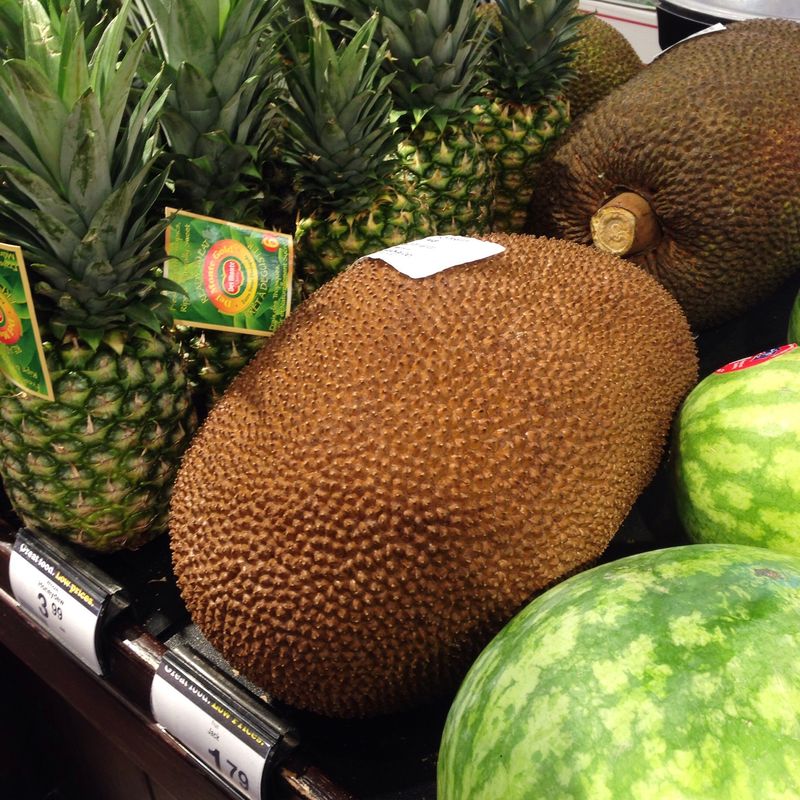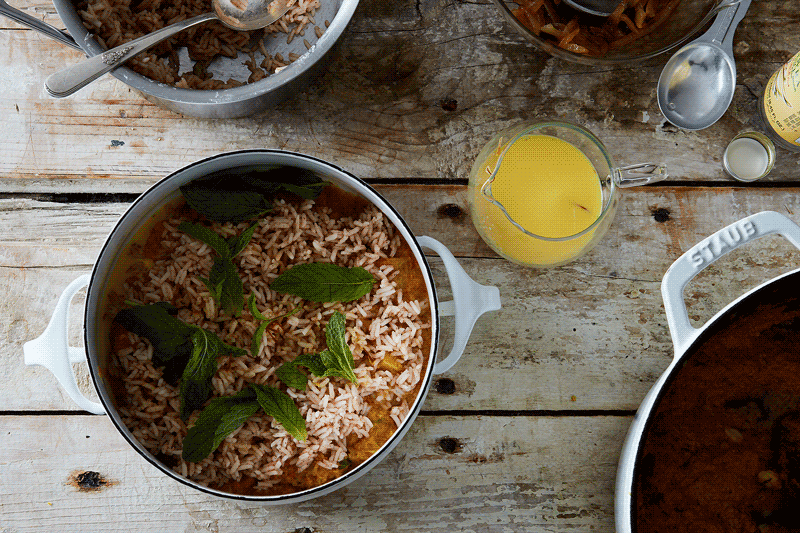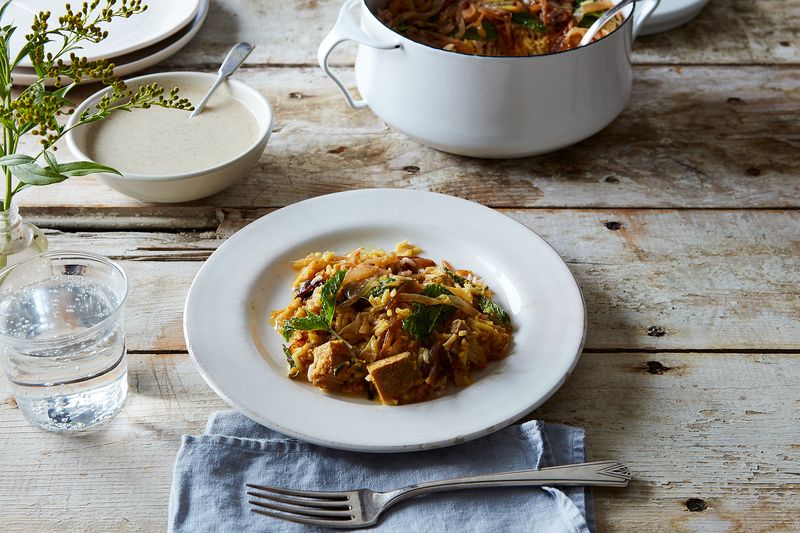I grew up in Dehradun, a city in the hilly state of Uttarakhand in Northern India, among staunch vegetarians. Where I’m from, that means no fish and no eggs. At 17, I relocated to Singapore and started experimenting with eating meat and cooking different cuisines. Nasi lemak and basil chicken became part of my weekly meal plan—but Indian non-vegetarian food just felt too foreign to me.
The first time I tried any kind of biryani, at the Hyderabadi Biryani House in Singapore, my palate resisted the texture of big chunks of chicken, as opposed to the minced pieces I was used to. Plus, I just associated those same Indian spices more with vegetables; the chicken did not feel right. Sure, there are many vegetarian biryanis, but I feel they oscillate between pilaf and rice with curry, and I wanted the flavor and texture of the chicken biryani without the big, tough chunks of actual chicken. So I considered my adventure with the widely-beloved dish over.

by Lindsay-Jean Hard
A couple of years later, I got married (to a vegetarian who does eat eggs) and moved to a suburb in western New York state. With him, I continued experimenting with different cuisines, leading to a particular love for Ethiopian food, and we began to throw dinner parties. We were united in a common goal: to find a meat substitute that did not compromise flavor or texture. But, as fate would have it, we were invited to a potluck in which our friends requested on thing in particular: biryani. It was the dish they relished at Indian restaurants. Uh oh. The usual procedure of calling my mom or mom-in-law would not work in this situation.
A few not-so-successful experiments and Google searches got my husband and me to a kathal (jackfruit) biryani recipe by Sanjeev Kapoor, a supremely popular chef in India. We had tried various side dishes made with jackfruit in the past, and found it had the fleshy and juicy feel of meat, and that it absorbed spices. At last, a solution.

Photo by Mark Weinberg
Now, Biryani is a time consuming and elaborate preparation. It’s is a royal delicacy, after all: Historically, it was served in royal courts of the nizams (rulers) of Hyderabad and Lucknow. Today, it’s usually made on occasions like weddings, when people want to celebrate or welcome guests. The key stages of getting the dish ready include the marination of “chicken” (or other meat, or jackfruit), cooking of fragrant rice, and the application of technique called dum, or sealing, which preserves and blends all the flavors. There is an extensive use of spices and it can be made extremely hot (by adding more spices such as garam masala) or rich (by adding cashew nut paste or heavy cream), depending on the preference of the chef.

Photo by Mark Weinberg
Since jackfruit is less dense than meat, marination works differently. I have tried different variations of baking and frying jackfruit, experimenting with spice levels, and have settled on frying jackfruit and then cooking it in a curry so it absorbs flavor, like a stew. The curry’s consistency is crucial. It should not be very thick and definitely not watery, either. The first time I served the jackfruit biryani, there was some need for improvement, but we knew we were getting close to wooing the chicken-and-rice lovers.
Here are some of the things I have learned on this multi-continental journey:
- It’s usually very helpful to prepare the ingredients beforehand (frying the jackfruit, chopping onions, making the puree, etc.).
- Cutting the jackfruit cubes into small pieces makes it easier to eat and more absorbent of flavor

Photo by Mark Weinberg
- It’s important to get the rice just right. The concept of al dente doesn’t only apply to pasta! If the rice is mushy, the texture is completely ruined when you layer the biryani (learned this the hard way).
- On that note, use basmati rice!
- The kind of vessel you use for layering will impact how evenly the dish gets cooked. I use a dish that is 4-inch deep. The shape does not matter, as long as there’s room to layer the rice and jackfruit curry evenly.
- Balancing the spices that provide fragrance with the ones that provide heat is important. I like to keep the heat to medium and put more premium on aromatics.
- You have to serve it with a side of mint raita (yogurt). All other sides don’t live up to the standards of good mint raita.

Photo by Mark Weinberg
Nowadays, at potlucks, I am asked to bring my signature dish. You don’t get a prize for guessing what it is.
This post originally ran in May. We’re running it again because we love biriyani.
Jackfruit Biryani
By Sneha Gupta
Jackfruit and Curry
-
1
can green jackfruit, peeled and sliced -
enough oil for deep-frying
-
2
green cardamom pods -
1
black cardamom pod -
2
whole cloves -
1
cinnamon stick -
1/2
teaspoon caraway seeds -
1
teaspoon turmeric powder -
2
teaspoons coriander powder -
1/2
teaspoon red chili powder -
2
tablespoons ginger, minced -
1
tablespoon garlic, minced -
1/2
tablespoon green chilies, minced (with seeds removed) -
2
onions, chopped -
4 or 5
medium-sized tomatoes, halved -
4
tablespoons olive oil -
1/3
cup whole milk yogurt, whisked -
1/4
cup coriander leaves
Rice and Layering for Biryani
-
3/4
cup Basmati rice -
2
cups water -
1
green cardamom pod, cracked -
1
black cardamom pod, cracked -
2
cloves -
1/4
tablespoon cinnamon powder -
2
mint leaves -
FOR LAYERING
-
1/4
tablespoon saffron -
2
tablespoons milk -
2
pinches of garam masala -
a heaping handful of mint leaves
-
1
tablespoon kewra water -
1
onion, chopped and caramelized
Simple Mint Raita (Yogurt Sauce)
By Sneha Gupta
-
1
cup plain yogurt (whole milk or reduced fat) -
1/2
cup water -
2
teaspoons dried mint powder -
1
teaspoon cumin powder (roasted, if you can find it) -
1
teaspoon red chili powder -
salt, to taste
(via Food52)







